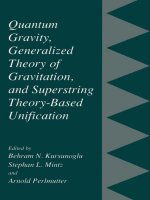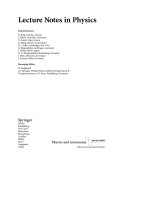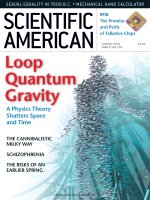Gravity surveying...
Bạn đang xem bản rút gọn của tài liệu. Xem và tải ngay bản đầy đủ của tài liệu tại đây (2.47 MB, 90 trang )
m1m2
!!!
F =G
2
r
1
Gravity - Truong Quoc Thanh
8/17/2016
Introduction
Gravity surveying…
Investigation on the basis of relative variations in the
Earth gravitational field arising from difference of
density between subsurface rocks
2
Gravity - Truong Quoc Thanh
8/17/2016
Application
Exploration of fossil fuels (oil, gas, coal)
Exploration of bulk mineral deposit (mineral, sand, gravel)
Exploration of underground water supplies
Engineering/construction site investigation
Cavity detection
Glaciology
Regional and global tectonics
Geology, volcanology
Shape of the Earth, isostasy
Army
3
Gravity - Truong Quoc Thanh
8/17/2016
Structure of lecture
1. Basic theory
2. Density of rocks
3. Gravity of the Earth
4. Measurement of gravity
5. Gravity reduction
6. Gravity anomalies and interpretation
7. Microgravity: a case history
8. Conclusions
4
Gravity - Truong Quoc Thanh
8/17/2016
1. Basic Theory
5
Gravity - Truong Quoc Thanh
8/17/2016
Gravity?...Rocks?...Huh?
We all feel and see gravity’s effects:
Weight (i.e. a force) & downward acceleration
The gravitational force depends on the rocks below us
If the rocks beneath the surface change with location, we
expect that the gravitational force we experience will also
change.
If we measure small changes in gravitational forces we
can use this information to make inferences about the
rocks below us.
This is the essence of gravity surveying
6
Gravity - Truong Quoc Thanh
8/17/2016
Newton’s Law of Gravitation
Sir Isaac Newton (1642-1727):
Consider two point masses that are a distance r apart.
Newton’s theory of gravitation predicts that they will attract each
other with a force F that is given by:
F =G
m1
force
r
m1m2
r2
force
m2
The quantity G is called the gravitational constant (or “big G”) but
is actually a small number. Newton deduced this equation from
observing the motion of planets and moons in the solar system. The
units are as follows:
F
Newton (N) r
metres (m)
m
kg
G = 6.67 x 10-11
Nm2kg-2
7
Gravity - Truong Quoc Thanh
8/17/2016
Newton’s Law of Gravitation
Newton’s law applies to point sources of mass
m1
force
r
force
m2
Earth isn’t a point source
Non-point sources are treated as the sum of the forces of many
small parts of the body
Because force is a vector, the vector sum must be calculated
This can become computationally intense for odd shapes
For some simple geometric shapes the result is simple…
8
Gravity - Truong Quoc Thanh
8/17/2016
Newton’s Law of Gravitation
For the gravitational attraction due to a hollow shell or
uniform sphere:
The force is the same as that of a point source of the same
mass located at the center of the sphere
This is true only outside the sphere.
At the center, the gravitational force must be zero (vectors all cancel
due to symmetry)
9
Gravity - Truong Quoc Thanh
Because Earth is approximately spherically symmetrical
(recall this from the seismology chapter?), we can treat
the Earth as a point source of mass located at the center
of the Earth!
8/17/2016
Acceleration Due to Gravity
Because Earth acts like a point source of mass…
We can use Newton’s universal gravitation eq to calculate gravitational force
on a small mass, ms, on the surface of the Earth
F =G
M E ms
2
RE
To consider acceleration…
Insert Newton’s second law to solve for the force on the small body…
F = ms g = G
M E ms
2
RE
The small body's mass cancels out, and we are left with the equation for the
acceleration due to gravity, g.
g =G
ME
2
RE
This relationship implies that all bodies on earth’s surface should experience
the same falling acceleration
10
Gravity - Truong Quoc Thanh
8/17/2016
Acceleration Due to Gravity
Let us now consider that m1 is the Earth and m2 is a small
object that we are going to drop. This equation tells us that the
acceleration does not depend on the mass of the object
being dropped
This was proved by Galileo who allegedly dropped masses
from the leaning tower of Pisa in Italy. This result says that a
small mass and a large mass will fall with the same
acceleration.
11
Gravity - Truong Quoc Thanh
8/17/2016
Acceleration Due to Gravity
Because Earth acts like a point source of mass…
So long as the mass of the Earth is spherically-symmetrical…
The acceleration due to gravity is independent of an object’s properties (mass,
etc…)
So far as gravity is concerned, the Earth could be:
Hollow in the middle
Made of cheese and gold
(So long as the mass was held constant)
We know that Earth isn’t exactly spherically-symmetrical…
E.g. lateral changes in rock type
Topography
Mantle plumes
We should therefore be able to measure small changes in g and determine
subsurface rock properties that involve variations in mass.
12
Gravity - Truong Quoc Thanh
8/17/2016
The mass of Earth
Although the mass of Earth is not practical to measure, it
can be easily calculated:
g =G
ME
2
RE
G = universal gravitational constant = 6.672 x 10-11 m3kg-1s-2
g = 9.81 ms-2 (can be measured for falling objects)
RE = can be measured from surveys or geometric observations
Eratosthenes (~200 B.C.) ~ 6370 km
ME = 5.97 x 1021 Mg or 5.97 x 1024 kg
13
Gravity - Truong Quoc Thanh
8/17/2016
Units of gravity
• 1 gal
= 10-2 m/s2
• 1 mgal = 10-3 gal = 10-5 m/s2
• 1 µgal = 10-6 gal = 10-8m/s2 (precision of a
gravimeter for geotechnical surveys)
• Gravity Unit: 10 gu = 1 mgal
• Mean gravity around the Earth: 9.81 m/s2 or
981000 mgal
14
Gravity - Truong Quoc Thanh
8/17/2016
Keep in mind…
…that in environmental geophysics, we are
working with values about…
0.01-0.001 mgal ≈10-8 - 10-9 g !!!
15
Gravity - Truong Quoc Thanh
8/17/2016
2. Density of rocks
16
Gravity - Truong Quoc Thanh
8/17/2016
Densities of Common Rocks
Rocks have a range of densities*
But in general, rock density does not widely vary
What does this say about typical gravity anomaly sizes?
Type
Rock
Density
Unconsolidated
Sand
1400-1650 kg/m3
Sedimentary
Salt
2100-2600
Limestone
2000-2700
Shale
2000-2700
Granite
2500-2800
Basalt
2700-3000
Quartzite
2600-2700
Gneiss
2600-3000
Galena
7400-7600
Pyrite
4900-5200
Magnetite
4900-5300
Igneous
Metamorphic
Ore
17
Gravity - Truong Quoc Thanh
8/17/2016
Densities of Common Rocks
Type
Rock
Density
Unconsolidated
Sand
1400-1650
kg/m3
Sedimentary
Salt
2100-2600
Rocks in the phreatic / vadose
Limestone
2000-2700
zone
Fractured / unfractured rocks
Shale
2000-2700
Granite
2500-2800
Basalt
2700-3000
Quartzite
2600-2700
Gneiss
2600-3000
Galena
7400-7600
Pyrite
4900-5200
Magnetite
4900-5300
Which has higher / lower density?
Surface / deep rocks
Weathered / unweathered rocks
• Which rock types make good
targets for gravity surveying?
• Which don’t
• Why
18
Gravity - Truong Quoc Thanh
Igneous
Metamorphic
Ore
8/17/2016
Densities of Common Rocks
Igneous
rocks
are
generally
more
dense
owing to minimal porosity.
Why Mafic rocks are more
dense than felsic rocks?
Type
Rock
Density
Unconsolidated
Sand
1400-1650
kg/m3
Sedimentary
Salt
2100-2600
Limestone
2000-2700
Shale
2000-2700
Granite
2500-2800
Basalt
2700-3000
Quartzite
2600-2700
Gneiss
2600-3000
Galena
7400-7600
Pyrite
4900-5200
Magnetite
4900-5300
Igneous
Metamorphic
Ore
19
Gravity - Truong Quoc Thanh
8/17/2016
Densities of Common Rocks
Variation in porosity is the main cause of density variation in
sedimentary rocks. Thus, in sedimentary rock sequences, density
tends to increase with depth, due to compaction, and with age, due
to progressive cementation.
Most igneous and metamorphic rocks have negligible porosity, and
composition is the main cause of density variation. Density
generally increases as acidity decreases; thus there is a progression
of density increase from acid through basic to ultrabasic igneous
rock types.
20
Gravity - Truong Quoc Thanh
8/17/2016
Densities of Common Rocks
Density is commonly determined by direct measurements
on rock samples. A sample is weighed in air and in water.
The difference in weights provides the volume of the
sample and so the dry density can be obtained. If the rock
is porous the saturated density may be calculated by
following the above procedure after saturating the rock
with water.
The density of any particular rock type can be quite
variable. Consequently, it is usually necessary to measure
several tens of samples of each particular rock type in
order to obtain a reliable mean density and variance.
21
Gravity - Truong Quoc Thanh
8/17/2016
3. Gravity of the Earth
22
Gravity - Truong Quoc Thanh
8/17/2016
3.1 Shape of the Earth: spheroid
• Spherical Earth with R = 6371 km is an approximation!
• Rotation creates an ellipsoid or a spheroid
Re − R p
Re
1
=
298
Re= 6378 km and Rp= 6357 km. The ratio of flattening is
approximately 1/298. Since a point on the Equator is further from
the center of the Earth than the poles, gravity will be slightly
stronger at the Equator.
If we move from pole to the equator, the gravity will
decrease 6480 mgal
23
Gravity - Truong Quoc Thanh
8/17/2016
3.2 Centrifugal acceleration and potential
The rotation of the Earth also causes gravity to vary.
Imagine you are standing at the North Pole. The rotation of
the Earth will not change g, all that will happen is that you
rotate once a day.
Now imagine you are at the Equator. If we could
increase the rotation rate of the Earth enough, you would be
ultimately be thrown into space (i.e. become weightless).
Thus rotation makes gravity weaker at the equator.
24
Gravity - Truong Quoc Thanh
8/17/2016
3.2 Centrifugal acceleration and potential
𝐦𝐦𝐯𝐯 𝟐𝟐
𝐦𝐦𝐦𝐦 =
𝐝𝐝
At equator d = R = 6378km
V = ω 2 R2
=> g = ω2R
c
If we move from pole to the equator, the gravity will
decrease 3373 mgal
25
Gravity - Truong Quoc Thanh
8/17/2016









